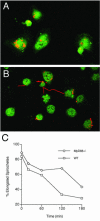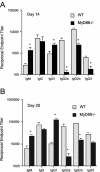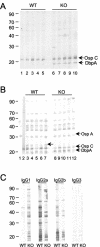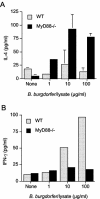Myeloid differentiation antigen 88 deficiency impairs pathogen clearance but does not alter inflammation in Borrelia burgdorferi-infected mice
- PMID: 15155621
- PMCID: PMC415708
- DOI: 10.1128/IAI.72.6.3195-3203.2004
Myeloid differentiation antigen 88 deficiency impairs pathogen clearance but does not alter inflammation in Borrelia burgdorferi-infected mice
Abstract
The spirochete Borrelia burgdorferi causes acute inflammation in mice that resolves with the development of pathogen-specific adaptive immunity. B. burgdorferi lipoproteins activate innate immune cells via Toll-like receptor 2 (TLR2), but TLR2-deficient mice are not resistant to B. burgdorferi-induced disease, suggesting the involvement of other TLRs or non-TLR mechanisms in the induction of acute inflammation. For this study, we used mice that were deficient in the intracellular adapter molecule myeloid differentiation antigen 88 (MyD88), which is required for all TLR-induced inflammatory responses, to determine whether the interruption of this pathway would alter B. burgdorferi-induced disease. Infected MyD88(-/-) mice developed carditis and arthritis, similar to the disease in wild-type (WT) mice analyzed at its peak (days 14 and 28) and during regression (day 45). MyD88(-/-) macrophages produced tumor necrosis factor alpha only when spirochetes were opsonized, suggesting a role for B. burgdorferi-specific antibody in disease expression. MyD88(-/-) mice produced stronger pathogen-specific Th2-dependent immunoglobulin G1 (IgG1) responses than did WT mice, and their IgM titers remained significantly elevated through 90 days of infection. Despite specific antibodies, the pathogen burden was 250-fold higher in MyD88(-/-) mice than in WT mice 45 days after infection; by 90 days of infection, the pathogen burden had diminished substantially in MyD88(-/-) mice, but it was still elevated compared to that in WT mice. The elevated pathogen burden may be explained in part by the finding that MyD88(-/-) peritoneal macrophages could ingest spirochetes but degraded them more slowly than WT macrophages. Our results show that MyD88-dependent signaling pathways are not required for B. burgdorferi-induced inflammation but are necessary for the efficient control of the pathogen burden by phagocytes.
Figures





Similar articles
-
MyD88 plays a unique role in host defense but not arthritis development in Lyme disease.J Immunol. 2004 Aug 1;173(3):2003-10. doi: 10.4049/jimmunol.173.3.2003. J Immunol. 2004. PMID: 15265935
-
MyD88 deficiency results in tissue-specific changes in cytokine induction and inflammation in interleukin-18-independent mice infected with Borrelia burgdorferi.Infect Immun. 2006 Mar;74(3):1462-70. doi: 10.1128/IAI.74.3.1462-1470.2006. Infect Immun. 2006. PMID: 16495516 Free PMC article.
-
Dual role for Fcγ receptors in host defense and disease in Borrelia burgdorferi-infected mice.Front Cell Infect Microbiol. 2014 Jun 11;4:75. doi: 10.3389/fcimb.2014.00075. eCollection 2014. Front Cell Infect Microbiol. 2014. PMID: 24967215 Free PMC article.
-
Chemokines and Toll-like receptors in Lyme disease pathogenesis.Trends Mol Med. 2005 Mar;11(3):114-20. doi: 10.1016/j.molmed.2005.01.003. Trends Mol Med. 2005. PMID: 15760769 Review.
-
Mechanisms of Borrelia burgdorferi internalization and intracellular innate immune signaling.Front Cell Infect Microbiol. 2014 Dec 15;4:175. doi: 10.3389/fcimb.2014.00175. eCollection 2014. Front Cell Infect Microbiol. 2014. PMID: 25566512 Free PMC article. Review.
Cited by
-
Pathogenesis of Borrelia burgdorferi and Babesia microti in TLR4-Competent and TLR4-dysfunctional C3H mice.Cell Microbiol. 2021 Sep;23(9):e13350. doi: 10.1111/cmi.13350. Epub 2021 Jun 9. Cell Microbiol. 2021. PMID: 33938125 Free PMC article.
-
Lymphoadenopathy during lyme borreliosis is caused by spirochete migration-induced specific B cell activation.PLoS Pathog. 2011 May;7(5):e1002066. doi: 10.1371/journal.ppat.1002066. Epub 2011 May 26. PLoS Pathog. 2011. PMID: 21637808 Free PMC article.
-
Temporal Role for MyD88 in a Model of Brucella-Induced Arthritis and Musculoskeletal Inflammation.Infect Immun. 2017 Feb 23;85(3):e00961-16. doi: 10.1128/IAI.00961-16. Print 2017 Mar. Infect Immun. 2017. PMID: 28069819 Free PMC article.
-
Borrelia burgdorferi Engages Mammalian Type I IFN Responses via the cGAS-STING Pathway.J Immunol. 2023 Jun 1;210(11):1761-1770. doi: 10.4049/jimmunol.2200354. J Immunol. 2023. PMID: 37067290 Free PMC article.
-
CD14 signaling restrains chronic inflammation through induction of p38-MAPK/SOCS-dependent tolerance.PLoS Pathog. 2009 Dec;5(12):e1000687. doi: 10.1371/journal.ppat.1000687. Epub 2009 Dec 11. PLoS Pathog. 2009. PMID: 20011115 Free PMC article.
References
-
- Adachi, O., T. Kawai, K. Takeda, M. Matsumoto, H. Tsutsui, M. Sakagami, K. Nakanishi, and S. Akira. 1998. Targeted disruption of the MyD88 gene results in loss of IL-1- and IL-18-mediated function. Immunity 9:143-150. - PubMed
-
- Akira, S. 2003. Mammalian Toll-like receptors. Curr. Opin. Immunol. 15:5-11. - PubMed
-
- Alexopoulou, L., V. Thomas, M. Schnare, Y. Lobet, J. Anguita, R. T. Schoen, R. Medzhitov, E. Fikrig, and R. A. Flavell. 2002. Hyporesponsiveness to vaccination with Borrelia burgdorferi OspA in humans and in TLR1- and TLR2-deficient mice. Nat. Med. 8:878-884. - PubMed
-
- Aliprantis, A. O., R.-B. Yang, M. R. Mark, S. Suggett, B. Devaux, J. D. Radolf, G. R. Klimpel, P. Godowski, and A. Zychlinsky. 1999. Cell activation and apoptosis by bacterial lipoproteins through Toll-like receptor-2. Science 285:736-739. - PubMed
-
- Armstrong, A. L., S. W. Barthold, D. H. Persing, and D. S. Beck. 1992. Carditis in Lyme disease susceptible and resistant strains of laboratory mice infected with Borrelia burgdorferi. Am. J. Trop. Med. Hyg. 47:249-258. - PubMed
Publication types
MeSH terms
Substances
Grants and funding
LinkOut - more resources
Full Text Sources
Medical
Molecular Biology Databases

